Australasia 1985: Breaking with Britain

Decolonization of the Pacific
1788–1859 Australasian Colonies
1859–1901 Colonial Consolidation
1901–1941 Southern Dominions
1941–1945 War in the Pacific
1945–1987 Decolonization of the Pacific
1987–pres Modern Australasia
Breaking with Britain
As late as 1941, British dominance in Australasia and the South Pacific was unchallenged. By the 1970s this era was over, with Britain joining the European Community and abandoning almost all its remaining colonies. Australia and New Zealand responded by reinventing themselves, revamping their economies, and, in the case of N.Z., adopting a fierce anti-nuclear policy which irritated both the United States and France.
This map has in-depth notes in the Journal, exclusive to Patrons on Classical Tier and above. Find them in the events descriptions, marked with the Journal icon .